Menu
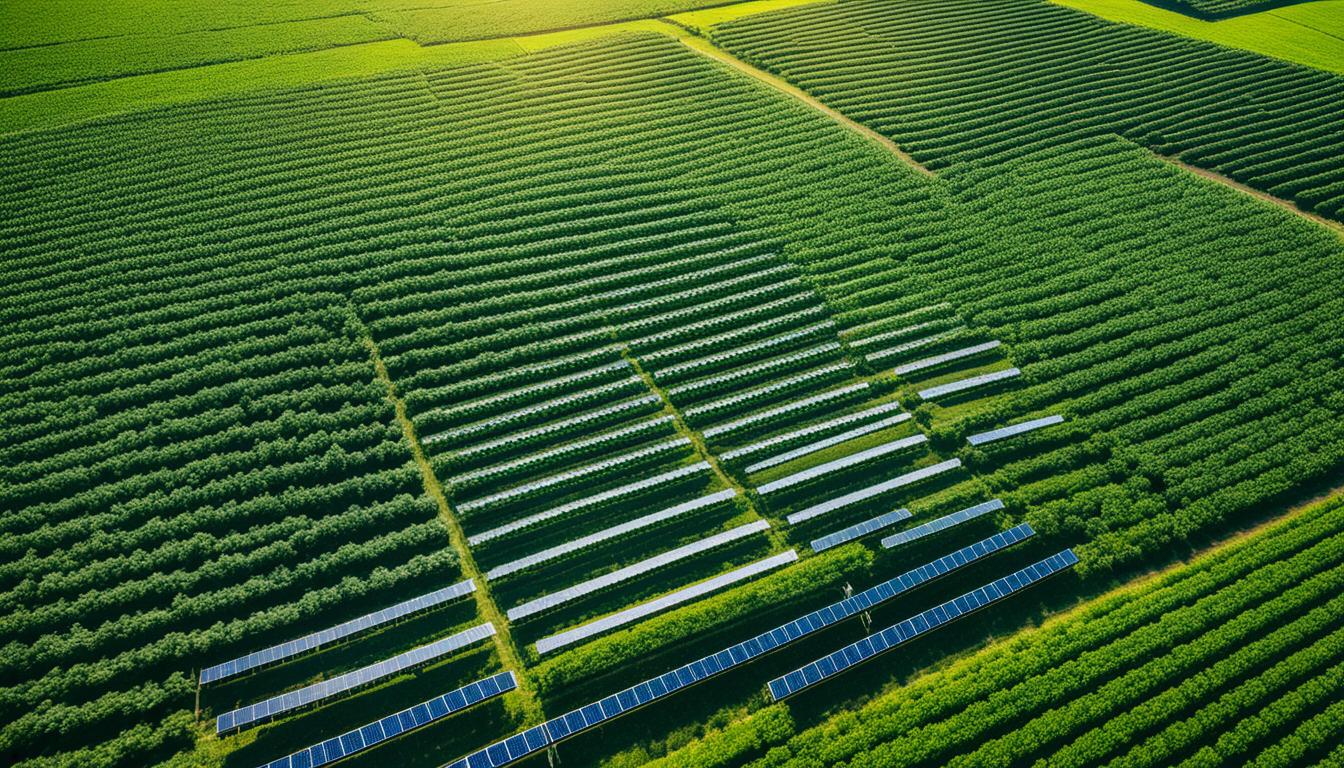
In 2023, precision agriculture will be at the forefront, using tech like GPS and IoT devices. This approach aims to make farming more efficient and increase crop production. Rebekah Shields, a leader in Global Recruitment in Agriculture, says farming is changing because of climate change and new technologies. This change means farmers need to keep up with new trends like precision farming and using more renewable energy. Rebekah’s insights are key as we look into sustainable agriculture trends for the upcoming year.
In 2023, sustainable farming is vital due to Brexit’s challenges and economic changes. Farms in the UK are changing how they operate. They’re using new tech and offering better pay to find and keep workers.
Farmers must keep up with grants and schemes to improve their practices. This shift aims to meet today’s needs while not harming tomorrow’s resources. Since the 1940s, farming has changed a lot because of new tech and more chemicals. But, these changes have hurt the environment.
Now, the focus is on sustaining the earth for future generations. Water scarcity and poor soil health are big concerns. Sustainable practices seek to use water wisely, cut pollution, and keep soil healthy.
Today’s shoppers like foods that are good for people and the planet. A mix of sciences, economics, and community choices drives this green shift. Sustainable farming is complex but doable. It involves small steps that fit with what families and individuals can do.
The U.S. is discussing a new Farm Bill to support sustainable farming. This bill can protect a $20 billion fund for green farming. It’s the largest Farm Bill investment in conservation since the Dust Bowl era.
The Farm Bill supports practices that help land and water stay healthy. It includes ways to care for land not in use and to keep working farms eco-friendly. Sustainable farming must deal with many demands over time. It must also adapt to people’s and nature’s ever-changing needs.
Balancing production, profits, protecting the environment, and meeting society’s needs is a must. This process must keep getting better and face up to new challenges. Sustainable agriculture is key to ensuring food is available and to fighting hunger worldwide.
Precision agriculture is the heart of modern farming, using the latest tech to use resources better and boost crop growth. It brings together tools like GPS, drones, and IoT devices to collect and study data live. This changes the old ways of farming to new, smart methods that rely on data.
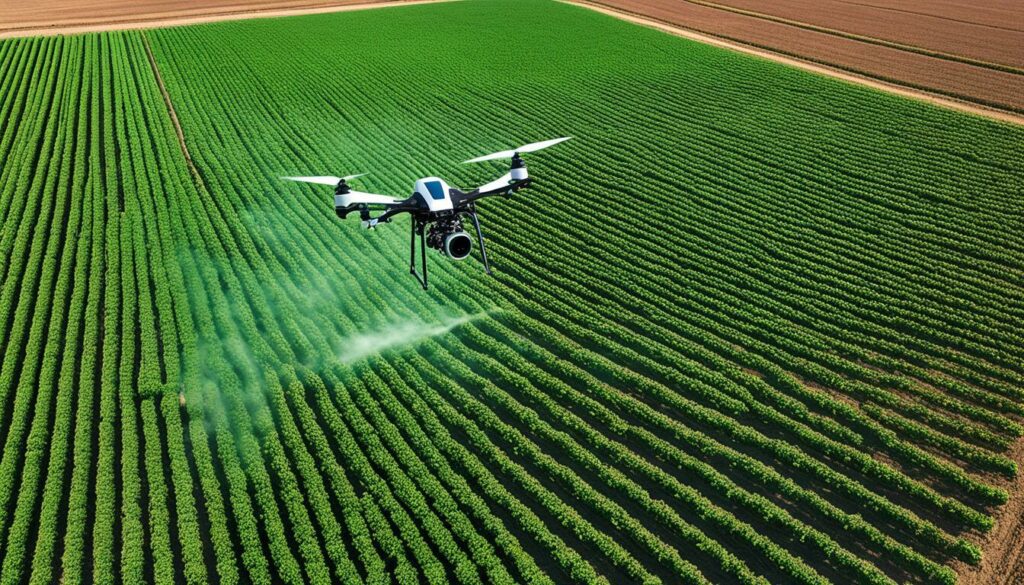
Precision agriculture started advancing in the 1990s, moving from simple gadgets to using GPS-guided machinery and drones. GPS lets farmers map out their fields and control their equipment with great accuracy. Drones fly overhead, taking detailed pictures. These images help farmers see how their crops are doing and understand the condition of the soil.
IoT is a game-changer in farming, by instantly gathering and looking at data. Soil and crop sensors watch over the plants’ health by checking nutrients and water. With the help of IoT, John Deere uses data and machine learning to help farmers with smart decisions. This is all about using accurate data.
Precision agriculture brings many benefits. It lets farmers get quick updates on their crops’ health using satellite images. It also helps them understand their land, like its shape and water flow, with GIS. Machines that run themselves and systems that water automatically cut mistakes and save resources.
With big data and clever tools, it’s possible to predict trends and get the most out of crops. This makes farming more sustainable and efficient.
Renewable energy is changing farming fast. It’s crucial because farming uses a lot of energy globally. Solar power in agriculture, wind energy, and biomass solutions help make farming more eco-friendly and productive.
Solar power in agriculture is great for farms. It uses the sun, which is everywhere. It’s cheap and can grow as a farm does. Solar power helps cut electricity costs and is green. Farmers can save money and even make some by selling extra power.
Wind energy is perfect for farms with lots of wind. Wind turbines make electricity day and night. They keep farms running smoothly. Using wind power lowers pollution and can earn money through electricity sales.
Biomass solutions create power right on the farm. They help cut down waste and emissions. One cool use is a system for greenhouses that controls temperature and CO2 with biomass. This shows how biomass boosts farm efficiency and output.
| Renewable Energy Source | Advantages | Applications |
|---|---|---|
| Solar Power | Abundant sunlight, low operating costs, scalability | Net-zero energy greenhouses, thermal energy storage |
| Wind Energy | 24/7 electricity generation, abundant wind resources | Electricity for greenhouses, reducing GHG emissions |
| Biomass Energy | On-site power generation, waste reduction | Greenhouse temperature and CO2 control systems |
Using renewable energy is key for farms to use less fossil fuel and spend less on power. It makes farms more self-reliant, so they can keep working even without the grid. Overall, choosing renewable energy is both a smart and eco-friendly move for the future of farming.
Regenerative farming is an approach that makes farming more natural. It aims to make our farms work like nature does. This new way of farming is good because it uses less chemicals and improves how the land works. Farmers who do this see more types of plants and animals on their land. They also have better and healthier soil.
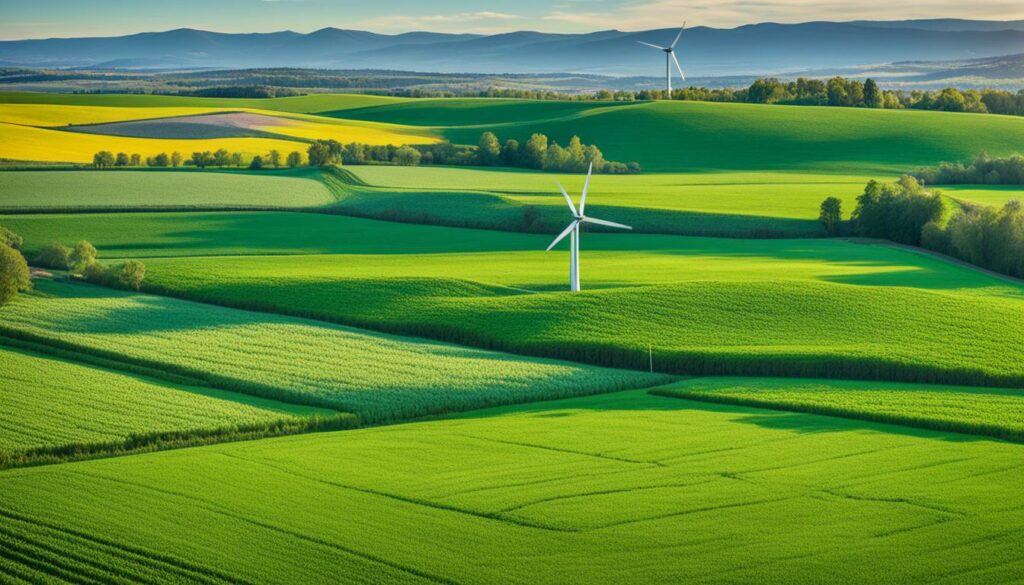
Regenerative agriculture enhances nature. It makes the soil stronger and encourages plants to grow well. It also makes sure the nutrients in the soil are used in a natural way. To do this, farmers use methods like permaculture, agroforestry, and managing land in a holistic way. These methods help keep the soil healthy without tilling. A study in 2022 found that cotton farmers saved money and earned more by using these methods.
Big companies are starting to support regenerative farming, too. PepsiCo and Walmart are putting money into a project to help U.S. and Canadian farmers have healthier soil and water. General Mills is also joining in. They plan to have a lot of their farming done in a regenerative way by 2030.
Small companies are doing big things as well. A tech startup in Seattle called Aigen has sold all its products for the next few years. These products use green energy to help farmers. This shows that people care more about farming that helps the planet. The regenerative farming market is expected to be worth almost $3 billion by 2030, showing big growth.
Farmers who do regenerative farming see better crops, spend less on chemicals, and are better able to deal with bad weather. In addition, this type of farming helps fight climate change by saving carbon in the soil. More and more cotton farmers in the U.S. are leading the way in this eco-friendly farming. They are showing how farming that cares for the land can also be a good business.
The world is getting hotter, and the weather is getting wild. This makes it crucial to farm in ways that help fight these changes. By adapting how we grow our food, we can make sure we have enough to eat while also protecting the planet. Several smart ways of farming have become very important.
As more and more people need food, we must find ways to grow it even when water is scarce. Drought-resistant crops are designed to survive without much water, and they provide good harvests. For example, China is investing a huge amount in such crops. It also helps lower harmful gases and supports more plant and animal varieties.
Conservation tillage helps keep the soil healthy by disturbing it as little as possible. This technique is key in fighting climate change, protecting against soil loss, and storing carbon. It is particularly beneficial for the environment since farming is one of the biggest sources of air pollution.
Since farming uses a lot of water, it’s vital to manage this resource well. Practices such as careful irrigation, collecting rainwater, and better ways to store water can save a lot of water. In Africa, a big investment is being made to teach farmers these efficient water-saving methods. This helps farms stay strong even when the weather is unpredictable.
Since the 1920s, agroecology has been a key topic in science. It started in FAO regional meetings, focusing on ten key elements. This method helps fight the quick loss of genetic diversity in our food. It does so by using agroforestry, creating wildlife corridors, and boosting biodiversity in agriculture. These steps mark a big change towards making farming sustainable.
Agroforestry joins farming with forest techniques to make land use better. This old practice improves the soil, water, and plant and animal life variety. For example, in Micronesia, it’s bringing back crops rich in nutrients like orange-fleshed bananas. These bananas have 50 times more beta-carotene than the usual ones. This makes a big difference in local health.
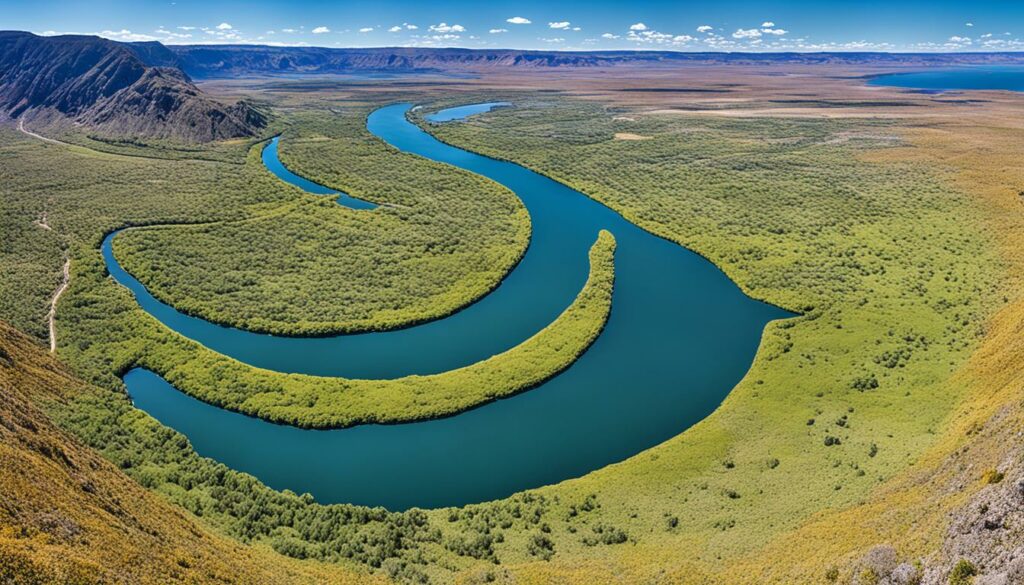
Setting up wildlife corridors is vital in agroecology. They help animals move safely between farmlands. This way, they mix their genes and help rare species live on. In India, Brazil, and Senegal, these lanes are proving very useful. They make the farm ecology stronger, helping with pollination and pest control.
Agroecology really boosts different kinds of life in farming. For example, growing certain plants together can save farmers millions by reducing the need for chemical nitrogen. Plus, 15% of this nitrogen comes from animal waste. This shows agroecology can wisely use resources and care for the environment.
| Benefit | Explanation |
|---|---|
| Economic Viability | Agroecological practices can increase farmers’ income and productivity, as highlighted through studies in various countries. |
| Ecosystem Services | Enhanced pollination, improved soil health, and pest control are direct benefits of diverse agroecological systems. |
| Social Impact | Greater social equity, empowerment, and strengthened community networks stem from agroecology’s integrative approaches. |
| Environmental impact | Approaches like conservation tillage and rotational crop-fish systems promote environmental sustainability and recovery. |
Agroecology, when combined with nature recovery, harmonises farming with the natural world. These methods open the door to lasting, strong farming systems. They support the environment and bring benefits to people too.
For 2023, sustainable agriculture trends are key. They include regenerative agriculture, renewable energy, and agri-tech. 75% of millennials choose products based on their impact on the planet. This has led to more green farming practices. Whole Foods said regenerative agriculture is the top food trend for the future in 2020.
Big companies in the USA are looking to use regenerative farming on 50 million acres. This is part of the move towards sustainable food systems. Using bio-based materials in packaging can cut fuel use by 70%.
The International Energy Agency expects a record CO2 in 2023. Food processing, packaging, and waste are big contributors to this. It’s essential to cut carbon footprints, especially for retailers and food makers. Investors are showing they prefer companies with plans to reach net zero on carbon. This shows how important it is to reduce emissions in the food sector.
The agriculture UAV market is set to soar from $0.88 billion in 2020 to $5.89 billion by 2030. This growth is due to technology’s big role in greening agriculture. PwC says AI might cut global GHG emissions by 4% in 2030. This would come from progress in farming, water use, energy, and transport.
ICL is targeting carbon neutrality by 2050. They want to drop absolute greenhouse gas emissions by 30% and have half their energy from renewables by 2040. They also aim to recycle more waste water each year. Their efforts show how the trend for eco-friendly farming is set to grow in 2023.
In the changing world of farming, government support is key. Agricultural grants help farmers use sustainable methods. They also make the economy stronger. Governments offer many schemes to help farmers be more green, productive, and able to face climate changes.
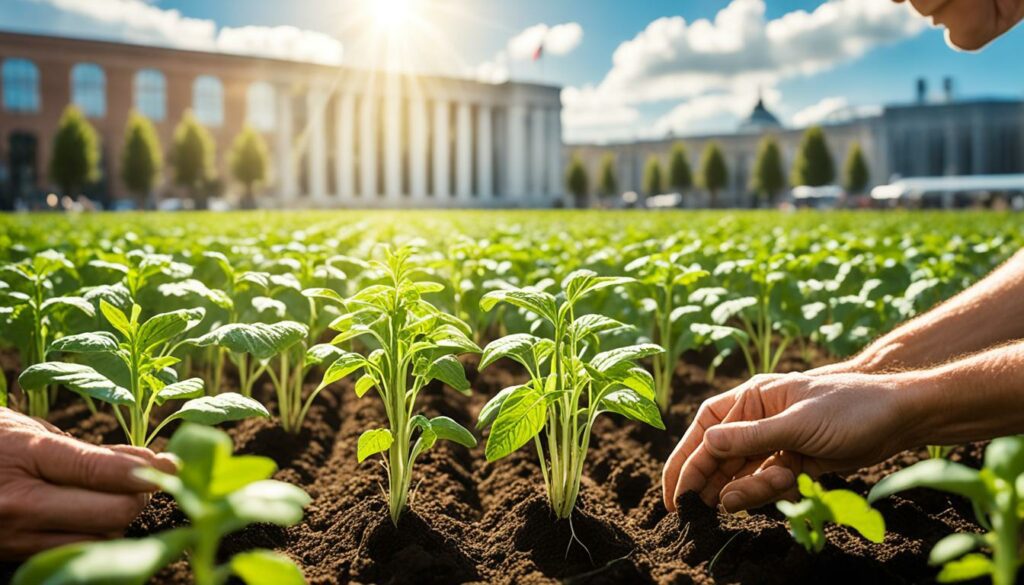
Farmers can find lots of grants to help them be more innovative and green. The Sustainable Agricultural Lands Conservation (SALC) Programme is one such example. It helps fund projects that cut down on greenhouse gases and help local areas. It offers different types of grants to help with planning, conservation, and project growth. These grants are a big chance for farmers to better their methods and grow their business.
Government help has made a big difference in making farming more eco-friendly. It tackles water pollution and promotes crops that can survive droughts. This helps save water and encourages friends of nature from different fields to come together. Because of these efforts, more farmers are now doing farming in ways that are good for the planet.
Getting agricultural grants is usually not too hard. It’s important to know the key dates and what the grants are for. For example, the SALC Round 10 has important dates to remember. Draft guidelines are up for review on July 24, 2024. The deadline to apply is July 3, 2025. Knowing and following these dates is a good way to get support for your farm’s green projects.
Check out this detailed timetable to help you understand how to apply for and receive support:
| Event | Date |
|---|---|
| Draft Guidelines Released | July 24, 2024 |
| Public Comment Closed | August 24, 2024 |
| Guidelines Adoption | October 31, 2024 |
| Acquisition and Planning Pre-proposals Due | January 31, 2025 |
| Applications Due (All Grant Types) | July 3, 2025 |
| Project Awards | October 2025 |
Organic farming is changing fast. It’s all because of a big focus on being good for the earth. People also want food grown in ways that help the planet. So, farmers are using new ways that are kind to nature. They’re also using cool tech and new farming methods.
At farming schools, things are different now. They teach more about organic farming and keeping nature rich. This helps the farmers of tomorrow learn how to grow food in ways that are good for our planet. They learn many of the newest tricks in organic farming.
Even tech is helping a lot. Drones are now used to watch over big farms instead of planes. This means farmers can spot pests and illnesses quicker. And this helps them keep more of their crops healthy. A farming style called vertical farming is also becoming popular. It lets farmers grow more in smaller spaces. This is great for big farms and people who farm as a hobby.
Going organic is hard work, but there are ways to make things easier. One cool idea is rewilding. It lets fields go wild again with native plants. This helps keep the soil from washing away and takes carbon out of the air. It’s a smart move for the planet.
Another good practice is regenerative agriculture. It’s all about farming without harming the soil too much. This means growing things like cover crops and changing what crops are grown in a field. These ways of farming make the soil healthier and the plants stronger without using lots of chemicals.
Kazakhstan’s government is also stepping up for organic farming. They have a plan to make farming in their country more sustainable by 2023. This means they are updating their farming laws and standards to better support organic farming.
| Country | Eligible Crops | Hectares Certified | Farms Certified |
|---|---|---|---|
| Kazakhstan | Wheat, Linseed, Soybeans | 200,000+ | 38 |
Worldwide, organic farming is growing fast. Kazakhstan, for example, sold $35 million of organic food in 2022. By using new and earth-friendly ways to farm, the future looks bright for organic farming.
Green agriculture technologies are driving innovation and efficiency. They help make farming more sustainable and tackle limited resources. Farming smarter is key to our planet’s future.
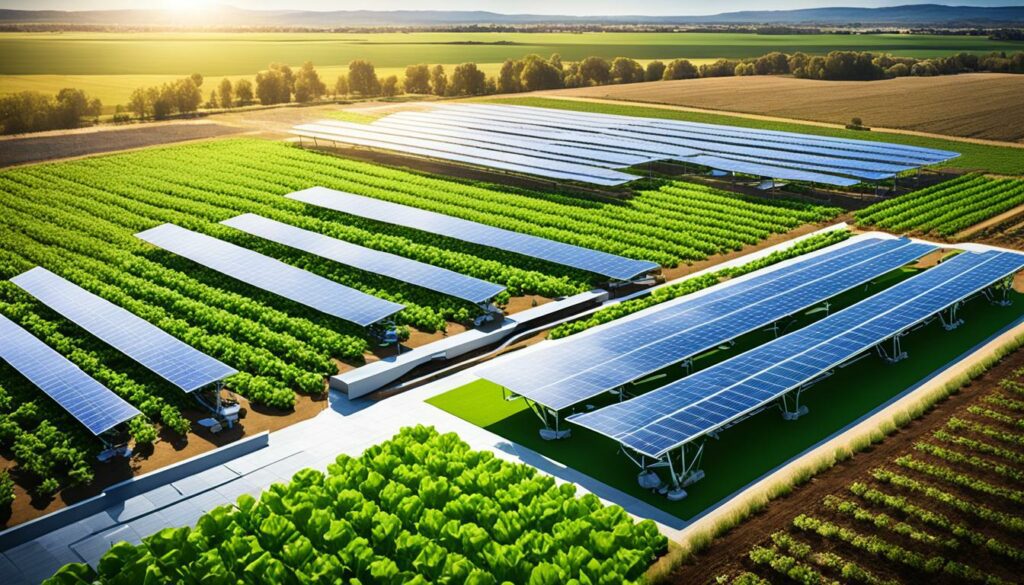
Smart irrigation is changing how we manage water in agriculture. It uses data in real time to water crops effectively. This saves water and keeps plants healthy. It also works hand in hand with precision farming to boost efficiency even more.
Vertical farming is turning heads by producing more using less space. It stacks crops on top of each other and grows them in special environments. This method is great for cities and cuts down on how much farming affects the environment.
Smart farming and vertical agriculture are making a big difference. They help us use resources wisely. Plus, they promote farming that’s good for the planet and produces a lot of food.
Table depicting the impact of green agriculture technologies:
| Technology | Benefit | Example |
|---|---|---|
| Smart Irrigation | Optimises water use | Real-time data integration |
| Vertical Farming | Maximises vertical space | Hydroponics in urban areas |
Pushing these technologies forward marks a big step in more efficient, planet-friendly agriculture.
The agriculture sector’s environmental impact is huge, mainly through agricultural carbon emissions. The EPA says that in 2021, agriculture made up 10.6 percent of America’s greenhouse gas emissions. It broke down into 46.6 percent nitrous oxide, 41.5 percent methane, and 11.9 percent carbon dioxide. These numbers led to around 671.5 million metric tons of CO2 equivalent from U.S. agriculture.
To cut these emissions, it’s vital to use sustainable emission strategies. This helps lower CO2 in farming and keeps our environment safe.
Agriculture significantly affects our climate. Over the past 115 years, our planet has warmed by about 1.8°F (1.0°C). This is closely linked with increased greenhouse gas emissions. The future looks tough for crops like corn, soybeans, and rice. They could suffer due to climate-smart agriculture methods.
Using new farming methods is crucial for lessening carbon emissions. For example, practices like minimal tillage and crop rotation help store carbon in soil. Also, planting drought-tolerant corn, which made up 22 percent of U.S. corn fields in 2016, can cut emissions. These crops withstand harsh conditions and reduce the agriculture sector’s carbon footprint.
Reducing CO2 in farming needs many sustainable emission strategies. Management of water, through methods like precision irrigation, helps save water and lowers emissions from needed energy. Using forests and grasslands effectively can also help by turning them into carbon sinks. This links farming to better environmental care.
| Emission Source | Percentage |
|---|---|
| Nitrous Oxide | 46.6% |
| Methane | 41.5% |
| Carbon Dioxide | 11.9% |
By focusing on agricultural carbon emissions with new methods and tech, we can make a big difference. This doesn’t just help the environment; it also makes farming more sustainable. This is key as we face ongoing changes in our climate.
Blockchain is changing agriculture, making food systems clear and supply chains easier to track. With the market value expected to grow from $285.34 million in 2022 to $7378.68 million by 2031, its impact is significant.
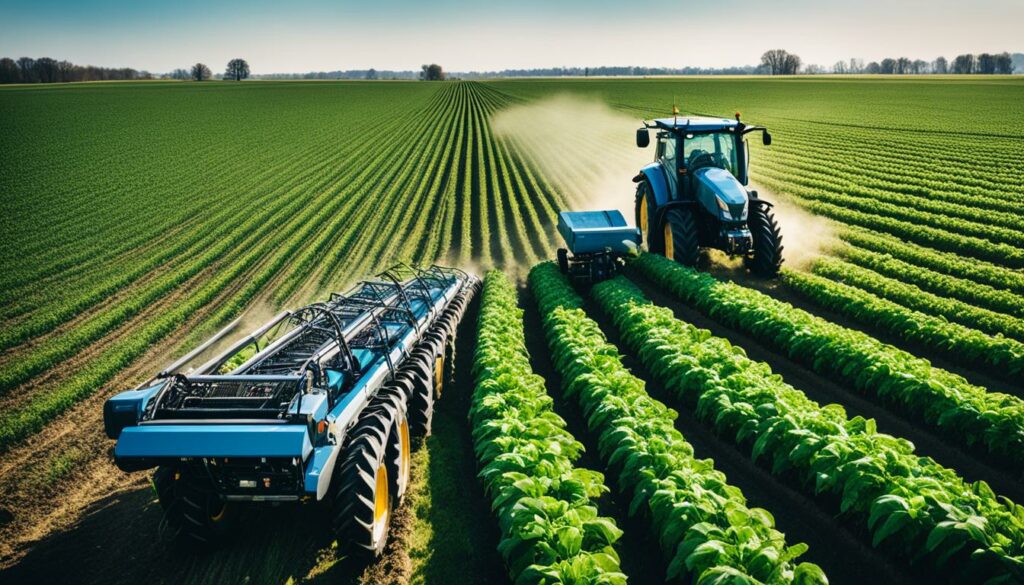
Blockchain in farming helps track food from the field to your plate. It tracks things like water, fertilisers, and energy, reducing waste. This tech can also reward farmers for using eco-friendly methods through smart contracts.
Blockchain makes food systems clear, letting farmers set their prices and talk directly to buyers. This cuts costs by skipping middlemen, boosting farmer profits. For those eating the food, it ensures it’s real and high quality, building trust.
It also records carbon emissions accurately, which helps with efforts like carbon credits. This supports a healthier planet.
During COVID-19, blockchain proved crucial. It let all users track their products fully, with 75% saying it made data easier to get. It’s becoming clear that with ERP systems, blockchain can make farming’s supply chains honest, efficient, and eco-friendly.
Robotics and automation are changing farming, helping manage increasing demand and worker shortages. By 2050, we’ll need to produce 70% more food. But over half of farm costs are for workers. And, 55% of farmers say there aren’t enough workers. To face this, more farms are using robots and automated equipment.
Autonomous tractors and drones lead the way in making farming more efficient. They reduce the need for manual work, cutting costs. For example, in the US, they can save $15 to $20 per acre on corn farms. This means, across the country, they could save nearly $1.5 billion a year. Drones help with gathering data on crops, soil, and pests, guiding smart farming choices.
Robotic harvesters are changing how we collect crops. A single strawberry robot can do the work of 30 people over three days in a 25-acre area. Less than 5% of farmers use this tech now. But it could save a lot of money, up to $800 per acre in some cases.
| Robotic Technology | Impact on Costs and Productivity |
|---|---|
| Autonomous Tractors | Save $15 to $20 per acre, $1.5 billion value annually across US corn farms |
| Robotic Harvesters | Replace 30 workers per 25 acres in 3 days, reduce labour costs |
| Drones for Data Collection | Real-time crop health and soil analysis, enhance decision-making |
In the end, using robots and automation can make farming cheaper and more productive. This helps meet the food needs of more people. The future of farming, with smart machines, looks bright.
The benefits of sustainable farming are changing how we see agriculture. They keep the environment balanced and help farmers earn more over time. It’s vital for those involved to see the green and the gold in this.
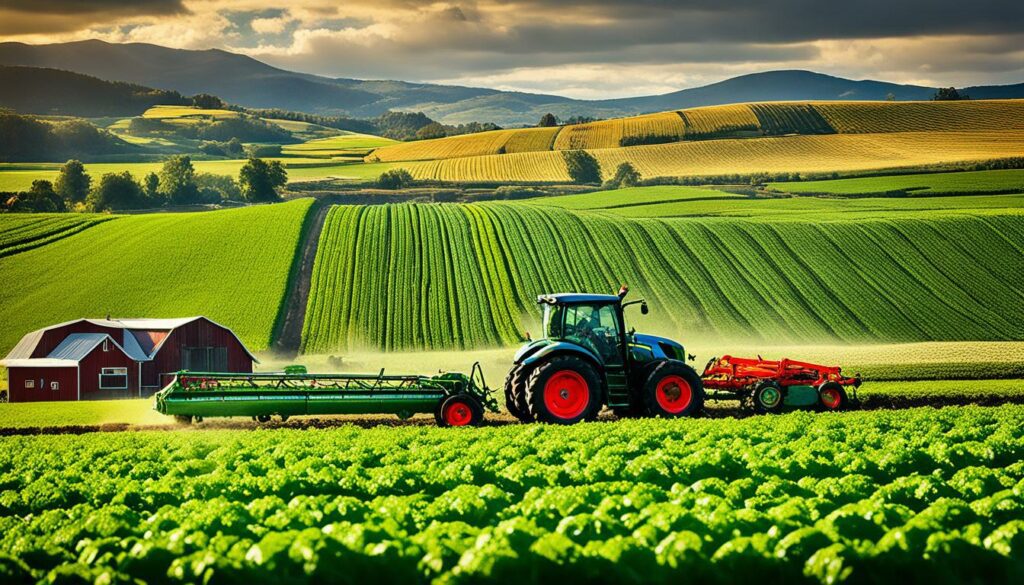
Looking at the costs and gains of sustainable farming is eye-opening. As farming techniques have improved, we’ve needed less land and fewer resources. This has kept global food production steady.
But, from 2011 to 2019, things changed. We started to use more land again. This highlights why we must keep improving our efficiency. Sustainable farming boosts both productivity and the health of the planet.
Sustainable farming plays a key part in feeding the world and ending poverty. It’s crucial, especially for places like Sub-Saharan Africa. Here, it helps to grow more food and fight poverty. By 2050, it’s expected to close 75% of the gap in food yield, making sure we can all eat and countering climate change.
These points show why we must focus on making farming sustainable worldwide. It tackles many challenges in the agriculture sector.
| Metric | Traditional Agriculture | Sustainable Agriculture |
|---|---|---|
| Land Use Efficiency | Lower | Higher |
| Resource Use | Intensive | Optimised |
| Long-Term Profitability | Variable | Consistent |
| Environmental Impact | High | Low |
These comparisons highlight how valuable sustainable practices are. They prove that choosing green over traditional is smart, both for the environment and the wallet.
The future of farming sustainability will rely heavily on new technologies and green innovations. These changes are constantly shaping the agriculture sector. They show us new ways of farming that may become common in the future.
New agricultural technologies are showing great promise. Methods like hydroponics, aquaponics, and vertical farming are becoming popular. They help the environment by using resources more efficiently. There’s also a move towards using waste to make biofuels or feed – known as circular agriculture.
Precision agriculture is key, using high-tech tools like GPS and satellite imagery to farm smarter. This reduces waste and boosts crop production. Regenerative farming works to make soil healthier by using methods like cover crops and rotating crops.
New tech is changing the game in farming sustainability. Agtech, artificial intelligence, and machine learning help in the field by allowing for real-time monitoring. The Internet of Things (IoT) gives farmers instant data on things like weather and crop health.
Renewable energy is also playing a big part, with solar and wind power cutting back on fossil fuels. This makes farming greener. And, with vertical farming, we can grow food in layers, saving space and resources.
Adapting to climate change is key. Farming techniques that cut down on greenhouse gases and help soil hold more water are becoming more important. These, along with new technologies, are creating a bright future for sustainable farming.
Looking ahead, the world of sustainable agriculture is about to change significantly. New technologies and clever policies are leading us to a more green and reliable food system. This shift is very positive, as I’ve found in my research. It’s bringing together the health of our planet, making money, and fairness for everyone. These are the key aims of changing how we farm.
Sustainable farming has grown a lot in the last forty years. More people are using these methods, which is a good sign. Projects like “MasAgro” in Mexico show how these methods can help farmers and the land. But, there are still big challenges. Some people worry about GMOs, and money can still be a problem. Keep going, as researchers and farmers need to work together to overcome these difficulties.
Protecting our world and the people in it is vital. Making sure we have enough now without hurting the future is key. Actions like not ploughing too much, changing the crops we grow, and planting cover crops are helping. Using the power of the sun and wind also cuts our climate impact, making our food more sustainable.
To really make a difference, we need to keep learning and taking action. The ability of the farming world to bounce back, change, and offer variety will keep it going strong. People wanting food that’s made in a sustainable way is a great motivator. It pushes the market in the right direction. The mix of new, green technology and caring for our planet is taking farming into a brand new chapter.
The key trends in sustainable farming for 2023 include precision agriculture. This is where high tech like GPS, drones, and IoT devices are used for detailed data collection. This helps farmers make better decisions to grow more and harm the Earth less.
There is also a focus on using more renewable energy. Farms are turning to solar power, wind energy, and energy from biomass. These efforts are backed by government support to also earn money in new ways.
Precision agriculture means using technology to farm better. It uses tools like GPS, drones, and smart devices to get information in real-time. This info helps farmers to make choices that boost their crop yield and protect the environment.
Farms now use solar panels, wind turbines, and biomass energy more than before. They do this with help from the government which supports these new energy efforts. It also means they can make money in different ways.
Regenerative farming aims to keep the soil healthy and preserve the environment. It uses fewer chemicals and tries to add more plants and animals. This way of farming helps to clean the soil, store carbon, and keep crops healthy and stable.
Farming in a sustainable way can make our food system strong against the effects of a changing climate. This means growing plants that can handle less water, saving energy when ploughing, and using water wisely. Such steps ensure the land stays good for growing food, helping us and the Earth in the long run.
Agroecology helps farming to work with nature. It includes planting trees on farms, making space for wild animals to move, and managing the land in ways that keep it alive and well. These practices support more plants and wildlife and make the soil better.
Next year, farming is likely to focus even more on being kind to the planet. You’ll see more farms making their own energy and using smart tech to grow food in better ways. People’s desire for eco-friendly food and government rules will push growers to do even more for the environment.
Grants and rules from governments are key to help farmers change how they farm. They support new ways that use less energy and protect the land. This help means farmers can keep up with the changing weather and protect our food for the future.
Organic farming is getting better at looking after nature while growing food. New methods and tools are all about being kind to the Earth. This includes working with natural cycles and finding ways for different plants and animals to help each other.
Green technologies in agriculture are making water and land use smarter. Tools like smart water systems and farming in stacked layers save resources. This means the land can keep growing food without getting tired out.
Traditional farming has a big impact on the planet’s health by creating a lot of greenhouse gases. Switching to methods that use less energy and take better care of the soil is crucial. It helps farming to give back to nature instead of just taking from it.
Blockchain is a special kind of technology that keeps clear records as food travels from farm to table. It makes it easier for us to know where our food is coming from and how it was made. This builds trust between farmers and buyers by ensuring the food is what it says it is.
Now, farming is getting smarter by using machines that can work on their own. These include self-driving tractors, flying drones, and robots that pick crops. Such smart machines help farmers do their jobs better, especially when there are fewer people to help.
Choosing to farm in ways that keep the land healthy is also good for business. It helps farms make more money, be stronger in hard times, and work better with others. This way, farming in a good-for-the-Earth way is also good for the pocket.
The future of farming is full of new technology that makes things easier and smarter. This includes using artificial intelligence and special sensors to farm well. People also want their food to come from farms that take care of the planet, which will drive changes in farming.